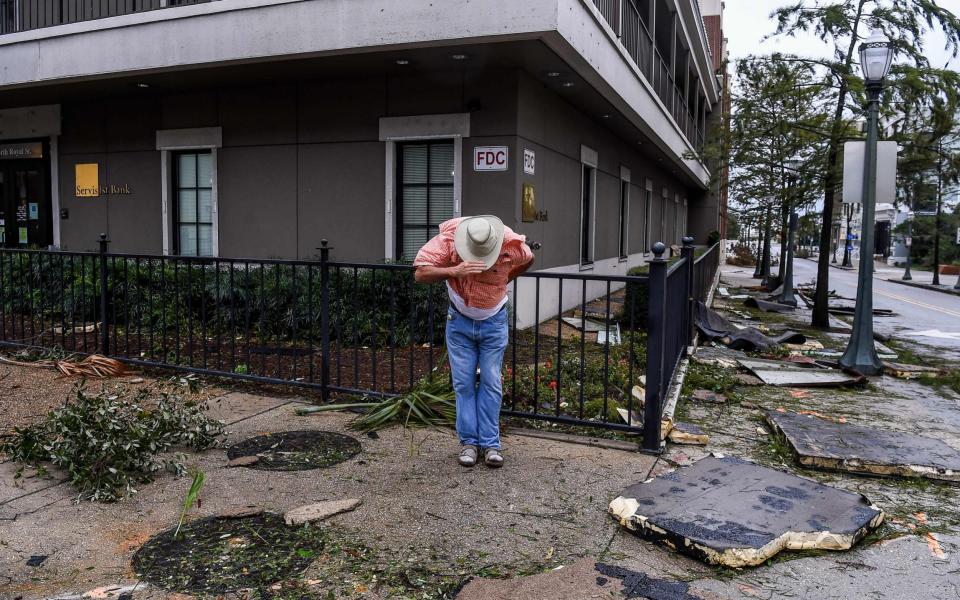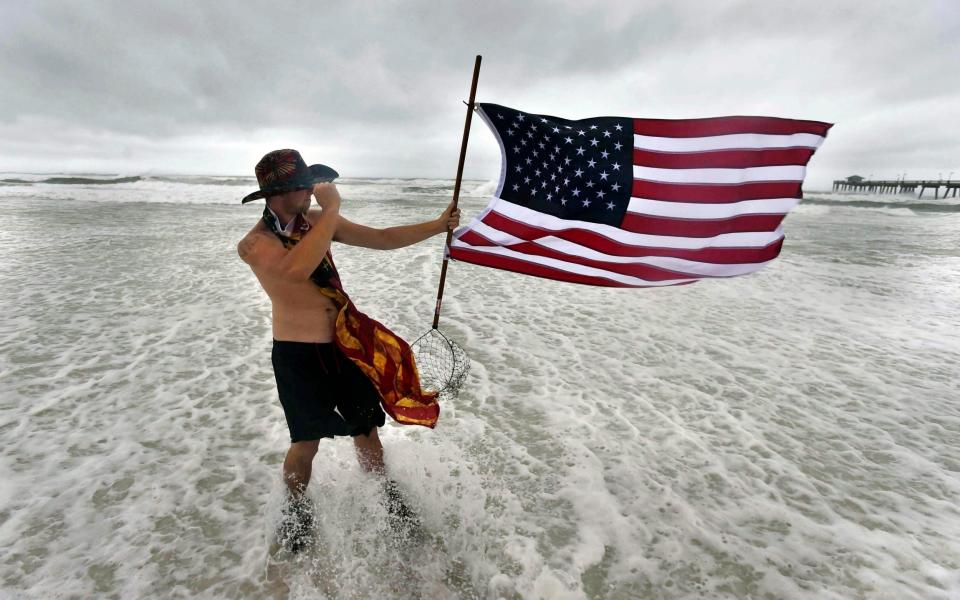'Life-threatening flooding' expected as Hurricane Sally makes landfall on US Gulf Coast

Hurricane Sally made landfall on Alabama's Gulf Coast on Wednesday morning as a Category Two hurricane, after winds intensified overnight. It has since reduced to a Category One storm but remains dangerous.
Winds were clocked at 105 miles per hour (165 km per hour), able to cause extensive damage, according to the five-step Saffir-Simpson scale. The hurricane also poses the risk of "catastrophic and life-threatening" flooding along portions of the north-central Gulf Coast, the National Hurricane Center (NHC) said in an advisory around 5 a.m. CDT (1000 GMT).
Flood waters are causing significant damage in Mobile, Alabama, and Pensacola, Florida, two cities with a combined metropolitan-area population of almost 1 million.

'It's uncommon to measure rainfall in feet'
The NHC earlier said the hurricane could bring more than 2 feet (60 cm) of rain to some areas as it creeps inland.
Emergency officials in Alabama and Florida reported flash floods that pushed water into homes. Tthe National Weather Service reported nearly 3 feet (1 meter) of water covered streets in downtown Pensacola.
"It's not common that you start measuring rainfall in feet," said National Weather Service forecaster David Eversole in Mobile, Alabama. "Sally's moving so slowly, so it just keeps pounding and pounding and pounding the area with tropical rain and just powerful winds. It's just a nightmare."
Sally's plodding pace may be a consequence of climate change, experts say. A 2018 study in Nature magazine found that translation speeds of all hurricanes and tropical storms had decreased by 10% between 1949 and 2016, a drop that was linked to an increase in total rainfall.
Damage from Sally is expected to reach $2 billion to $3 billion, said Chuck Watson of Enki Research, which tracks tropical storms and models the cost of their damage. That estimate could rise if the heaviest rainfall happens over land.

Mississippi, Florida in line to be hit
Sally made landfall at Gulf Shores, Alabama, and was creeping toward the Alabama-Florida border at 3 mph (5 kph). Its winds and rains will stretch from Mississippi to the Florida Panhandle, the NHC said.
More than 500,000 homes and businesses were without power in Alabama and Florida early Wednesday, according to local utilities, with more outages expected.
In Dauphin Island, Alabama, winds sustained 81 mph (130 kph), while in Pensacola, Florida, winds were at 61 mph (98 kph), NHC said.
In Mobile, Alabama, strong winds shook windows while trees and power lines swayed.
#Hurricane the center of the eye of category 2 hurricane #Sally makes landfall near gulf shores #Alabama...catastrophic and life-threatening flooding likely along portions of the north-central gulf coast... Pressure: 965 mb, Wind Speed: 105 mph https://t.co/7AdfVq2ojw pic.twitter.com/N3tpaewb7L
— Hurricane Tracker (@ushurricanebot) September 16, 2020
Ports, schools and businesses were closed along the coast as Sally churned. As the storm track shifted east, ports along the Mississippi River were reopened to travel on Wednesday. But they were closed to vessel traffic from Biloxi, Mississippi, to Pascagoula, Florida.
Energy companies also shut more than a quarter of U.S. Gulf of Mexico offshore oil and gas production and some refiners halted or slowed operations.
To compound fears, the National Weather Service has warned there is a slight risk, level two of five, of tornadoes forming in the wake of Sally.
"Hurricanes and tropical storms that make landfall in the Gulf of Mexico are more likely to produce tornadoes compared to storms in the Atlantic," said Brandon Miller, a meteorologist for CNN.
Water levels at NOAA tide stations along the Florida panhandle are continuing to rise following landfall of Hurricane #Sally. The Pensacola, FL station is experiencing moderate flood levels, over 5.5 feet above normal high tide. https://t.co/vaiXjzRee6 pic.twitter.com/orXhtGq7UX
— NOAA's Ocean Service (@noaaocean) September 16, 2020
Officials across the South had called on residents of low-lying areas to shelter away from the winds and rain. But for some, Hurricane Sally's slow approach brought a chance to relive childhood memories of storms past, and to witness the power of nature first hand.
Thomas Harms braved the wind and rains on Tuesday to watch the waves crash into the Fairhope Municipal Pier, and reminisced about past storms. As a child, he went with his grandfather to see storms arrive, and he did the same on Tuesday for his son.
"It kind of takes a little bit of the fear out of it and also help you understand the dangers of it too," said Harms. "I've been kind of passing that on to my son in doing the same thing."

Alabama facing 'record flooding'
A flash flood emergency has been issued by the National Weather Service for parts of the coast, near where Hurricane Sally made landfall.
Alabama governor Kay Ivey told a press conference: "We are looking at record flooding, perhaps breaking historic levels. And with rising water comes a greater risk for loss of property and life.
"I urge you in the strongest way possible to evacuate if conditions permit and seek shelter elsewhere as possible today."

Ms Ivey had declared a state of emergency Monday ahead of Sally's arrival.
President Donald Trump, speaking on "Fox & Friends," compared Sally to Hurricane Laura, which battered Texas and Louisiana, as well as the Caribbean, just a few weeks ago.
"This one is smaller but it's a little bit more direct, but we have it under control," he said. "We have it under watch very strongly."
Earlier, he tweeted: "We are fully engaged with State & Local Leaders to assist the great people of Alabama, Louisiana, and Mississippi."
He urged people in the storm's path to "listen to State and Local Leaders."

President Trump also issued emergency declarations for parts of Florida, Alabama, Mississippi and Louisiana.
Mississippi Governor Tate Reeves had also declared a state of emergency ahead of the approaching storm.
He said the storm surge projections were "worrisome with anywhere from five to eight feet of coastal surge."
Governor John Bel Edwards of Louisiana, which is still recovering after Hurricane Laura made landfall in the state as a Category 4 storm, told residents Monday to be prepared.
"Be smart and be safe," he tweeted.
My team and I are closely monitoring extremely dangerous Hurricane Sally. We are fully engaged with State & Local Leaders to assist the great people of Alabama, Louisiana, and Mississippi. Be ready and listen to State and Local Leaders! @GovernorKayIvey @LouisianaGov @TateReeves
— Donald J. Trump (@realDonaldTrump) September 15, 2020
At a hurricane refuge in Pascagoula, a coastal town in eastern Mississippi, 50-year-old evacuee Cliton Shepherd was hoping the area could avoid the worst.
"I don't think the wind is going to hurt anything, hopefully. I pray that it doesn't. But that's the main thing, you know, hoping and praying for the best, that's all we can do."
Record number of storms
It was the second hurricane to hit the Gulf Coast in less than three weeks and the latest blow in one of the busiest hurricane seasons ever recorded, so frenetic that forecasters have nearly run through the alphabet of storm names with 2 1/2 months still to go. At the start of the week, Sally was one of a record-tying five storms churning simultaneously in the Atlantic, strung out like charms on a bracelet.
For the 2nd time on record, the Atlantic has 5+ tropical cyclones (tropical depression (TD) or stronger) simultaneously: #Hurricane #Paulette, TD #Rene, Tropical Storm #Sally, Tropical Storm #Teddy and TD21. Other time was from September 11-14, 1971. pic.twitter.com/9ET1OoxE6f
— Philip Klotzbach (@philklotzbach) September 14, 2020
There have been so many tropical storms in the Atlantic this year that the UN's World Meteorological Organization, which names the tempests, is about to run out of names for only the second time in history.
The last time the UN's World Meteorological Organization ran out of names was in 2005, the year Hurricane Katrina devastated New Orleans.
Sally is one of five tropical cyclones in the Atlantic Ocean - a phenomenon only recorded once before, in September 1971, according to meteorologists.
The latest Atlantic storm, Hurricane Paulette, pounded the island of Bermuda on Monday with Category 2 winds and heavy rains, according to the NHC.
The center also said Tropical Storm Teddy, currently positioned in the mid-Atlantic, was expected to become a hurricane.

